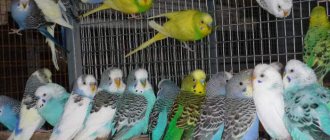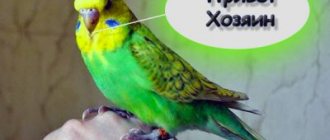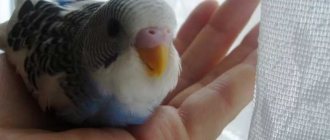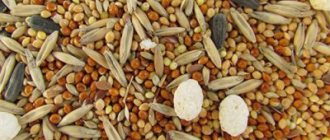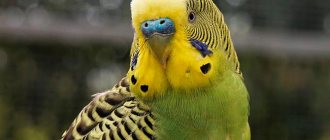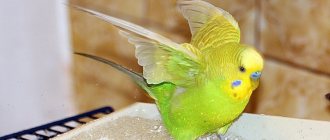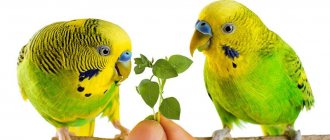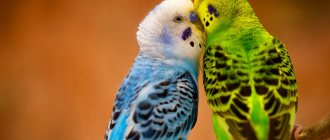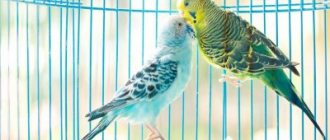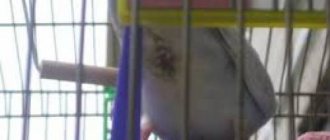- home
- Parrot
- Arrangement
11/07/2019 Moving to a new place and changing the environment for a budgerigar are one of the most stressful situations. For the little feathered newcomer, everything around is unfamiliar - sounds, smells, etc. It is not surprising that, once in a new living space, the acquired pet literally falls into a stupor of fear. Only correctly carried out adaptation of a budgie will help return the frightened bird to normal life and make it cheerful and cheerful again. The article describes how to properly conduct the adaptation period.
Cell preparation
It is recommended to purchase a house for a parrot in advance - at least 2-3 days before purchasing the bird itself. When moving into a cage that has already been prepared for the arrival of a feathered tenant, the adaptation period will be faster and easier.
Experienced breeders advise not to skimp on your pet and immediately purchase a good Italian-made cage for it - they are considered the best. The cost of such housing for a bird is high, but you should not be “tempted” by the cheapness of Chinese goods - this is an imaginary saving. Unlike Chinese products, cages from Italy are made from high-quality and reliable materials that are safe for birds. Such housing will last a very long time.
The minimum size of a house for one wavy is 40×25×30 cm. The purchased housing for a pet must immediately be equipped with the following items necessary for a comfortable stay for a feathered pet:
- feeders (not closing);
- drinking bowl (you can use the simplest one made of plastic);
- wooden perches (preferably from fruit trees; 2-3 pieces, each 1.5 cm in diameter);
- suspension ropes;
- wooden stairs;
- mirror;
- bathing suit
Before installing the parrot’s home in the place chosen for it, the cage and all its contents (from bowls to toys) must be disinfected - thoroughly washed with water and laundry soap and wiped dry. After this, all internal equipment is returned to its place and filler is poured onto the floor of the cage.
It is better to place a bird cage near a wall - this will at least partially give the pet a feeling of security. In addition, the location for placing the cage should be away from the following factors unfavorable for the bird:
- drafts;
- direct sunlight;
- heating devices;
- various equipment;
- noise sources;
- indoor plants.
A room suitable for placing a cage should be spacious, well-ventilated and, preferably, with windows (if there are none, an ultraviolet lamp should be placed near the bird’s home).
During adaptation, it is recommended to cover one of the side walls of the cage with opaque fabric. This will give the bird some privacy.
First preparations
Before you bring your parrot home, he needs to be equipped with a comfortable home. To begin with, a place is found in the apartment on which the cage will stand. When choosing, it is advisable to take into account the following nuances:
- First, purchase a spacious cage. The cage is placed away from radiators and household appliances. One side of the cage should be adjacent to the wall.
- There should be no drafts in the room.
- The pet should not be exposed to direct sunlight. It is not advisable to place it on the windowsill, next to indoor flowers and in the aisle.
- If the room does not have windows, additionally install ultraviolet lighting.
- The cage is placed at a height commensurate with the owner’s eye level.
When a place has been selected, a cage is purchased. The home should be clearly visible and spacious. In parrots, mobility significantly affects metabolism; the more space, the healthier the pet will be. During the period of adaptation of the budgerigar, two walls are covered with dark cotton cloth, so the bird can retire if it gets nervous. The necessary accessories are installed in the cage:
- Prepare a convenient feeder. Two or three wooden perches, preferably made from fruit tree branches with a diameter of about 15 mm. Properly selected elasticity and thickness of the perch has a beneficial effect on blood circulation in the paws and is a prevention against many diseases. The perches are placed motionless so that the bird does not fall down and get injured while sleeping.
- Several feeders, each for a specific type of food.
- Drinking bowl. For the first time, place a heavy container that is difficult to turn over. Water should always be at room temperature. If tap water is used, then it is left to stand for 10-12 hours and diluted with boiled water. Replace water daily.
- Pallet. Helps with daily cleaning without disturbing your pet.
- A bath of water. In hot weather it is a must. Warm water is poured.
- One or two toys.
To move the pet, use a small box made of thin plywood. Transportation time from the store to home should not exceed two hours. In winter, the cage is placed in a bag or wrapped in a thick towel; in summer, it is covered with a thin cloth, leaving an opening for air circulation. You cannot shake the cage, listen to loud music or smoke.
How to choose a budgie?
Parrot behavior in the first days at home
You need to transport the bird from the place of purchase to its new place of residence in a special bird carrier. Upon arrival home, the parrot must be released from its carrier into its personal home.
At first, the wavy will be sad and passive, as if he was depressed. You shouldn’t be afraid of this - to begin adaptation, such bird behavior is natural. In addition to a sad mood and apathy, the behavior of the wavy during this period is characterized by the following:
- lack of appetite and thirst;
- silence;
- immobility;
- problems with the gastrointestinal tract;
- throwing around the cage.
Adaptation of a budgerigar after purchase lasts on average from one to four weeks. It is very important in the next few days after the bird appears in the house to leave the pet to itself for a while and not force communication on it. Attempts to make friends with a bird that has not yet settled in a new place will not only not be crowned with success, but will also result in even more stress for the unfortunate parrot.
In the first 2-3 days of a bird’s stay in a new place, the owner’s task is limited only to cleaning the cage (changing the filler) and making sure that the pet has plenty of fresh food and drink.
How much food should a wavy eat per day?
Most pet parrots get a significant portion of their food from grain crops. One bird will eat on average no more than 2 teaspoons of this food during the day. Some gardeners immediately throw the entire daily ration into the feeder. This saves time, but can lead to excessive feed consumption.
Budgerigars do not tend to “fill their bellies” when they are full. But birds are quite capable of staining their food with scales or droppings. To avoid replacing the entire daily amount of food with a new one, experts recommend dividing the daily amount of food for parrots into several parts.
Important: for large breeds of birds, the daily feed intake is approximately 35-40 grams.
If the parrot is healthy, he will not only eat the usual amount of food, but will also not refuse his favorite treat. It is important that there is always drinking water in the poultry house. This helps wolves regulate the rate of digestion. The drinking bowl is washed and the water in it is renewed daily.
Interesting! As a rule, vegetable and fruit food for budgies is not limited. These products are offered to birds in the form of small pieces, cleared of seeds and the top layer of skin.
Is quarantine necessary?
Regardless of whether there are other pets in the house, it is necessary to keep the bird in quarantine. The minimum period is 2 days. At this time, the parrot should not have contact with anyone - neither with members of the owner's family, nor with other animals. Therefore, it is very advisable that during these few days of quarantine no one lives in the room with the bird and does not spend much time there - the owner can visit there a couple of times a day to make sure that everything is okay with the pet.
Age matters
Some sources claim that taming can be started regardless of the age of the necklace parrot. Know that this is far from true. A wild adult parrot, that is, more than three years old, can remain rude forever, no matter how hard you work. Not to mention very old individuals. The maximum that can be achieved is his calm attitude towards your approach to the cage.
The sooner the bird's habituation to humans begins, the more likely success is in the future. Therefore, the actions of the breeder from whom you purchase the chick will be a very good help in this process. Perhaps he will, to some extent, accustom the babies born in his house to his constant presence. In addition, parents can serve as a good example if they are well trained and do not show anxiety when interacting with a person.
We recommend purchasing a pet that is five to six months old and immediately starting training with it.
Care during adaptation days
Every day the owner must update the litter, water and food. The bird should be kept in a calm environment and protected from any stress. In addition, she needs to be protected from pungent odors; she should not have access to plants - neither indoor plants nor bouquets of flowers.
If the wavy does not eat, you should pour a little food on the bottom of the pet’s housing, and if it does not drink, pour water into a saucer and place it on the floor of the cage. From time to time you need to pamper your feathered pet with bird treats, accompanying the offer of treats with affectionate conversations and praise. In this case, the parrot should be called by the name chosen for it and as often as possible. Soon the pet will get used to it and will begin to joyfully respond to its name.
Possible reasons for refusing to eat
It is known that a healthy parrot always has a good appetite. The parrot will not take excess food from the feeder. If a bird does not eat or drink, there are serious reasons for this. In most cases, they develop into illness or stress. But it also happens that the decisive factor in a parrot’s forced starvation is cold.
Tropical birds are so thermophilic that they do not react to a drop in room temperature.
Stress
If your pet is new to your home, not eating for several days is a normal reaction to an unusual environment. A change of place of residence is always a big shock for a bird. Once the parrot gets used to the environment and new people, it will stop ignoring food.
All that is required from the bird owner is patience, as well as creating a peaceful environment in the room where the parrot’s cage is located. Don't force your pet's attention. After some time, the bird itself will take the initiative, begin to happily chirp and communicate with the person.
The nervous system of parrots is quite delicate. When changing habits, combined with natural timidity, birds can react with stress not only to a change of place of residence. Parrots often become very nervous when their water bowls, food composition changes, or when their cage is moved to a different location.
Interesting! If you cover 2 walls of the parrot's house with a dark cloth in the first days, the bird will calm down faster and feel safer.
Digestive system diseases
According to statistics, gastrointestinal disorders in budgies are quite common. If the cause of such ailments is emotional overload, the troubles will go away on their own. It is enough to wait 1-2 days. All this time the parrot cannot drink or eat.
If a bird has gastrointestinal disorders due to poor quality food, the illness will last longer.
Signs of a serious digestive problem in a wolf include:
Experienced breeders in this case immediately turn to a veterinarian for help. Many people try to alleviate the symptoms of suspected poisoning with Smecta or Enterosgel, which are added to the water. With this method of treatment, the bird is fed non-dairy, salt-free porridge.
The fruit and vegetable component of the diet is very important for the health of parrots. Each bird has different food preferences. A parrot may stop eating a particular fruit just because it has been offered a treat for several days in a row. In this case, the bird needs to find an alternative. Most toadstools love apples, apricots, pears, bananas and cherries.
Other reasons
Budgerigars rarely take feeding seriously. They will never eat what is given to them, but will choose foods that are familiar to them and are not dangerous. If your bird recently arrived at your home from a store or breeder, it likely did not receive fruits and vegetables for dessert.
It is not surprising that such a parrot initially refuses such things. He's just not used to it.
Unusual products
To introduce your parrot to a new food, wait patiently for him to taste small pieces of the treat. Experts recommend:
Plant foods can be served raw or cooked to your parrot. It is better to cut them or grate them. All root vegetables must be fresh and without signs of rotting.
The parrot masters each new product in 2-2.5 weeks. Don't give your pet several new treats at once. It is important to observe your parrot and notice how its digestive system reacts to treats. If bird droppings have become liquid and the bird is sad, the product should be immediately excluded from the diet.
Can't find food
This often occurs after the animal has changed cages or has adapted to a new territory. The parrot simply does not notice the feeder, so it does not eat.
In this situation, you can set up several containers of bird food and place them in the cage's litter box. This way, the bird will immediately find food and will not be hungry. Over time, unnecessary feeders are removed and only one remains - the one that the parrot likes the most.
Cold
We should not forget that the most comfortable temperature for domestic parrots is considered to be between 22 and 25 degrees Celsius. Signs that a winged animal is frozen include:
A parrot that is uncomfortable with a drop in room temperature always sits feathered and does not show any willingness to communicate. For emergency heating of poultry, a conventional incandescent lamp is used.
They place it near the cage, turn it on and monitor the condition of the bird. As soon as the bird is triggered, it will begin to move and chirp, and the heating will turn off. Do not allow the parrot to overheat (by breathing heavily with an open mouth).
Important! If the animal has a "doubtful" concussion or has had a recent injury, the parrot's heat lamp should not be used. In such a situation, it is better to slightly increase the power of the heating devices.
What not to do?
During the period of adaptation of the bird to its new place of residence, it is strictly prohibited:
- try to grab the wavy;
- shake the parrot's cage or knock on it;
- pick up the bird (during the first 2-3 weeks in the new home);
- letting the parrot out of the cage;
- smoking in a room with a bird;
- make any noise near your pet (play music loudly, shout, etc.);
- unexpectedly turn on the light in a room with a bird;
- Allow other animals, as well as small children, to approach the bird.
Each of these actions will cause severe trauma to the bird’s psyche, and nuances like smoking will also cause physical harm.
How to behave with a parrot for the first time
At first, you need to take care of the bird's peace. There is no need to turn on loud music, turn on the vacuum cleaner and other loud household appliances, especially when she falls asleep. You should not make sudden movements in front of your pet's cage, as this may cause fright. First, open the cage only to clean it, add food or pour clean water. At first he will not speak and may open his beak without making a sound.
There is no need to try to pick up a wavy household member. He may get scared and even peck his owner. For the first week or even month, you can cover one side of the cage with a gauze cloth. The bird will have somewhere to hide and this way it will quickly get used to the situation.
How to let a parrot out of its cage for the first time?
You can let the bird out for its first walk around the room only if:
- at least 2-3 weeks have passed since the wavy appeared in the house;
- the bird responds to its name;
- contact between the feathered pet and the owner is established;
- the bird calmly sits on its owner's hand.
If all these conditions are met, you can try to release your pet to fly free. It is important to make sure in advance that all windows and doors in the room are closed. The procedure is simple:
- Open the door of the bird's home.
- If the parrot does not fly out of the cage, offer him your hand and wait until the pet climbs onto your finger.
- Carefully carry it by hand outside the cage.
The first flight experiences of the wavy are of a comedic nature - awkward movements, falls, etc. It doesn’t matter - the bird’s nature will take its toll, and with regular training the parrot will become an excellent “pilot”.
After the first walk, the wavy will not rush back to its house. You can lure him into his personal home by pouring food on the bottom of his cage - when he gets hungry, the parrot will go inside, then you just need to close the door behind him. But for this trick to work, and for there to be a chance to return the pet to the house, you need to let it out for a walk hungry.
It is worth noting that if the parrot does not want to leave the cage, there is no need to try to pull it out by force. In such a situation, it is worth holding off on taking a walk.
What not to do
It will not be possible to tame a parrot from the first days. It is simply pointless to force your love and friendship on a bird. Birds cannot tolerate high-pitched conversations, as well as tobacco smoke, so these factors should be completely eliminated during the adaptation period.
Under no circumstances should you reach out to the parrot, or even worse, grab it on the first day. The bird will experience even more stress and will take much longer to adapt.
Another important point is small children. They can't wait to meet the parrot, play and cuddle it. It is necessary to explain to the child that a pet is not a toy, but a living creature that needs peace and quiet. As soon as the bird gets used to one person, it will be much easier to make contact with the rest of the household.
If the budgerigar is not the first bird in the house, then it will need at least 3 weeks of isolation to adapt. It is impossible to introduce the bird to its brothers earlier, otherwise it will increase stress. In addition, a panicking pet is more susceptible to infections and other diseases. Other birds can provoke the development of some disease.
List of Misconceptions
The most common mistakes made by beginners include the following:
- Transport the wavy from the place of purchase to the house not in a special carrier, but in a cage in which the pet will live.
- Let the bird fly around the room immediately after purchase.
- Move the house with the feathered tenant from one place to another.
- Stand near the cage for a long time.
- Sticking your hands into the cage and showing any kind of violence towards your pet.
- Deprive the bird of water or food.
All these actions are wrong and do not lead to anything good, so you should not repeat them after others.
We are looking for mutual understanding
It happens that the parrot does not respond to all the efforts of the owner and resists making contact. Any learning process is labor-intensive and requires patience.
The main reason why a parrot does not seek to get closer is fear. There are many sources: noise, the constant presence of strangers, harassment, darkness or animals in the house.
In this case, it is important to understand what exactly is the cause of fear. First, eliminate the source, then gradually indicate its presence, encouraging the bird
The next step is to systematically become familiar with the cause of the fear, and then try to build trust and a sense of security.
Budgerigars are naturally endowed with curiosity and communication. The main thing in taming is not to suppress the bird with your desires and not to force them to actions that frighten them. Trust between pet and owner is the key to a long friendship.
Pet selection criteria
The main criterion is whether you can create a comfortable living environment for him.
These concepts include:
Space - the cage should be of such a size that the parrot can move in different directions in it
Some large birds can only live outside the cage. Humidity, light and temperature conditions - for tropical birds it is important to have a warm room, additional illumination with a UV lamp, and a complete absence of drafts. Proper diet - there are vegetarians, there are omnivores, but they all need fresh, high-quality food, which can be expensive. The presence of a full set of necessary accessories - from the already mentioned cage to toys, swings, feeders, drinking bowls and other pleasant little things.. The rest - the bird must be healthy, not enter into irreconcilable conflicts with the rest of the household and pets, and also not irritate the owner beyond measure
This is especially important to keep in mind. A screaming parrot (and they are mostly like that) is something that not every person can get used to. And don’t be fooled by the fact that during the purchase he was silent and behaved in an exemplary manner. Therefore, if you like silence, it is better to buy aquarium fish
The rest - the bird must be healthy, not enter into irreconcilable conflicts with the rest of the household and pets, and also not irritate the owner beyond measure. This is especially important to keep in mind. A screaming parrot (and they are mostly like that) is something that not every person can get used to. And don’t be fooled by the fact that during the purchase he was silent and behaved in an exemplary manner. Therefore, if you like silence, it is better to buy aquarium fish.
